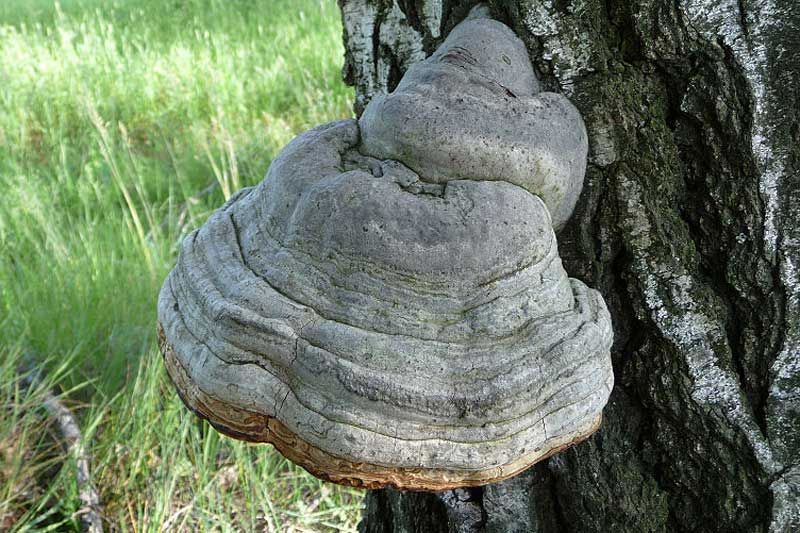Lorraine Julien | Feb 20, 2013
By Lorraine Julien
Anyone who has walked through the woods couldn’t help but notice bracket fungi. Tinder Conks belong to this large family of fungi that grow on trees. Some look like little shelves while others grow into a shape like a horse’s hoof. Although one of their favourite host trees is the birch, Tinder Conks are common on several types of dead and dying hardwoods, especially large oak and maple logs and stumps. The fungus may even live inside live trees, sometimes for many years. I had never heard of Tinder Conks until I recently read an article on them and their many uses.
Fomes fomentarius is the scientific name for Tinder Conks. Depending on the source, Fomentarius can mean either “used for tinder” or “dressing for wounds”! These fungi emerge as white foamy masses that harden and expand from a thin top down to a broad, flat shelf or a “horse’s hoof” (another name they are known by). Tinder Conks are perennials that can continue to grow for 30 years or more, or as long as the tree can feed them. Each summer and fall a new bottom layer is added to the bottom of the hoof shape.
During a damp period, just a few degrees above freezing, one Tinder Conk can spew up to 240 million spores per hour (every day, under ideal conditions – I wonder who did the counting!). This can happen even during the winter when the spores, having less competition, can spread more easily through the leafless forest. These polypores can break down wood cells that other decomposers have a hard time cracking. By the time this rotting process is well underway, other mushrooms, moulds and micro organisms join in, take and release nutrients for reuse in the forest – recycling by Mother Nature!
Common in northern forests around the world, Tinder Conk has been used in many ways for thousands of years:
As a fire source: Do you remember hearing about the Iceman, whose well-preserved, 5000-year-old body was discovered in 1991 in a glacier near the border of Austria and Italy? Beside his brass axe, bow and arrow and clothing, he carried with him a small leather pouch. Inside the pouch were the ground-up fibers of Tinder Conk, apparently ready for anything from starting an everyday fire to emergency medical treatment. Also in the pouch were several small, sharpened flint stones. The fungus must have been very important to the Iceman for him to carry it in a special pouch for such a long distance.
This discovery confirmed the fact that Tinder Conk has been used for thousands of years to start fires. Ancient peoples ignited conks by placing a tiny ember from a fire on the underside of the mushroom and gently blowing on it to stimulate ignition. The fibers from the conk would smolder for hours and could be carried from campsite to campsite by wrapping the embers in a dampened leather pouch (not so tightly as to suffocate it). The pouch was carried by straps.
If Tinder Conks are soaked and then pounded, the fibers separate – once dried, the resulting ‘wool’ makes excellent tinder.
Medicinal uses: These include a cauterization substance for wounds and to stop bleeding (described by Hippocrates in the fifth century BC). They were used in Europe as a remedy against bladder disorders and hemorrhoids; in parts of Asia as a diuretic, laxative and nerve tonic; and in China to treat cancers of the esophagus, stomach and uterus. Certain Aboriginal tribes used the heat retention properties of Tinder Conk to treat arthritis. In France, dentists still keep a supply of what they call “amadou” on hand for packing in the socket of a freshly pulled tooth. Amadou consists of Tinder Conk fungus pounded into fibers, dipped into a solution of saltpeter and allowed to dry.
Using modern methods, the tinder polypore has been shown to contain iodine, fomentariol and other substances that really are active against bacteria and against tumours. The tannic acids present in the woody fibers provide an antiseptic action and have the absorbent qualities of a sponge.
Other uses for the versatile Tinder Conk included: making clothing such as caps and chest protectors (after the fibers are pounded); using them as pincushions to prevent pins and needles from rusting; use by entomologists to mount insects; and in Siberia as snuff or mixed with tobacco. The list goes on.
Next time you’re walking in the woods, look for this unbelievable fungus. They’re most common on dead or dying birch, tree stumps and rotting logs.
Please feel free to report any observations to Lorraine Julien at This email address is being protected from spambots. You need JavaScript enabled to view it. or Steve Blight at This email address is being protected from spambots. You need JavaScript enabled to view it.
More Stories
- Province clarifies stance - Says Private Well Water Testing Will Continue
- Frontenac County Stays Internal for CAO - Appoints Kevin Farrell
- Addington Highlands Tax Bill Going Up 6.93%
- Perth Road United Church Donation to The Grace Centre
- 21 Years Of Dump Life Left At South Frontenac Waste Site
- Eclipse 2024 – Once In A Lifetime
- National Tourism Week
- NeLL Spring Open House and Anniversary Concert
- 25 years at Bishop Lake Outdoor Centre
- Grounds Contracts Down, Custodial Contracts Up In Central Frontenac

